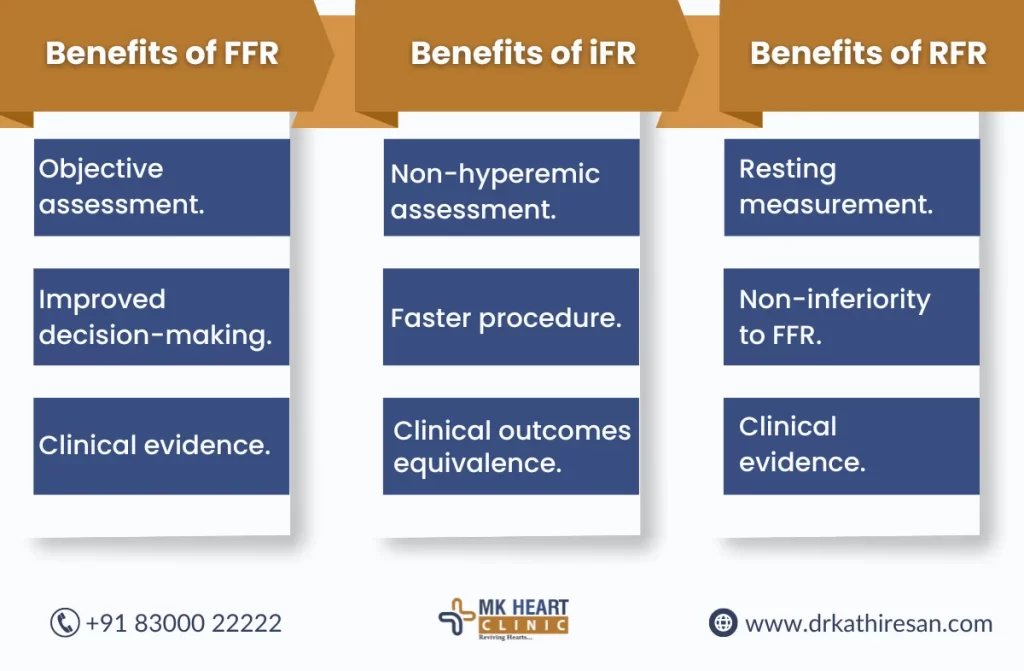Intracoronary physiology refers to the study of the functional status of coronary arteries within the heart. This is important for the diagnosis and management of coronary artery disease, which is a leading cause of death worldwide. There are three key intracoronary physiologic measures that are commonly used to assess the functional status of coronary arteries: FFR cardiology procedure, RFR, and IFR interventional cardiology.
- Fractional Flow Reserve (FFR): FFR is a measure of the pressure difference across a stenotic (narrowed) coronary artery and is used to determine the functional significance of a lesion. The FFR cardiology procedure is calculated as the ratio of the mean distal pressure to the aortic pressure, and values less than 0.75 are considered to indicate ischemia (reduced blood flow to the heart).
- Instantaneous Wave-Free Ratio (IFR): IFR is similar to FFR, but this IFR interventional cardiology is based on the assessment of blood flow during a specific period of the cardiac cycle (the wave-free period). The IFR provides a continuous measure of the functional significance of a stenotic lesion, with values less than 0.89 indicating ischemia.
- Resting Flow Reserve (RFR): RFR is a measure of the ratio of coronary blood flow at rest to maximum blood flow achievable during hyperemia (induced increase in blood flow). RFR is used to assess the physiological significance of stenoses in patients with stable angina or in those undergoing cardiac stress testing.

Diagnosis of FFR cardiology procedure
- The diagnosis of intracoronary physiology involves the measurement of Fractional Flow Reserve (FFR), Instantaneous Wave-Free Ratio (IFR), and Resting Flow Reserve (RFR) in patients with suspected or known coronary artery disease.
- The diagnosis of intracoronary physiology is used to determine the functional significance of stenoses (narrowings) in the coronary arteries, which can cause reduced blood flow to the heart and contribute to the development of chest pain (angina) or heart attacks.
Treatment
Before the FFR cardiology procedure, the patient will undergo a pre-procedural evaluation to assess their medical history, symptoms, and overall health. The patient may be asked to fast for a period of time prior to the procedure and to inform the healthcare team of any allergies or medications they are taking.
Then, a local anaesthetic is applied to the skin over the groin or wrist, and a small incision is made to access the femoral or radial artery. A catheter is passed through the incision and into the coronary arteries. The catheter is equipped with sensors and a pressure wire to measure blood pressure and flow within the coronary arteries.
- Measuring (FFR): The pressure wire is used to measure the pressure difference across a stenosis (narrowing) in the coronary artery for the FFR cardiology procedure. The pressure difference is then used to calculate FFR, which provides information on the functional significance of the stenosis.
- Measuring (IFR): The catheter is used for IFR interventional cardiology to measure blood flow during a specific period of the cardiac cycle (the diastolic phase), which is used to calculate IFR. IFR provides information on the severity of stenoses and their impact on blood flow.
- Measuring (RFR): The catheter used during the RFR in cardiology procedure measures resting blood flow in the coronary artery and to measure maximum blood flow achievable during hyperaemia (induced by the administration of adenosine or papaverine). The ratio of resting blood flow to maximum blood flow is then used to calculate RFR, which provides information on the ability of the coronary vasculature to respond to increases in blood flow.
After the procedure, the patient will be taken to a recovery area for monitoring. The results of the intracoronary physiology measures of FFR, RFR, and IFR interventional cardiology will be reviewed, and the healthcare team will use the information to determine the best course of treatment for the patient.
Benefits
The benefits of the FFR, IFR, and RFR in cardiology include the following:
- Improved diagnostic accuracy.
- Better patient outcomes.
- Reduced exposure to radiation.
- Cost-effectiveness.
Risks
There are also potential risks associated with intracoronary physiology measures. These include,
- Bleeding or infection at the site of access after the FFR cardiology procedure.
- Allergic reactions to contrast dyes or medications.
- Rare but serious complications such as cardiac arrhythmias or heart attacks.
Facilities
The technology and facilities used for intracoronary physiology, especially for the FFR, IFR, and RFR in cardiology, including
- Diagnostic coronary angiography.
- Pressure and flow measurement devices.
- Cardiac catheterization laboratories.
Our Doctors
Dr. M. Kathiresan will discuss the potential benefits and risks of the procedures relating to FFR, IFR, and RFR in cardiology with the patient and provide informed consent. Additionally, he will monitor the patient during and after the procedure and provide any necessary post-procedural care.

